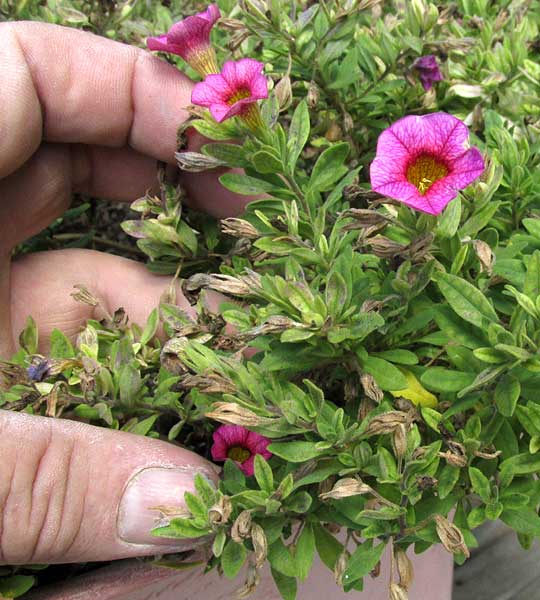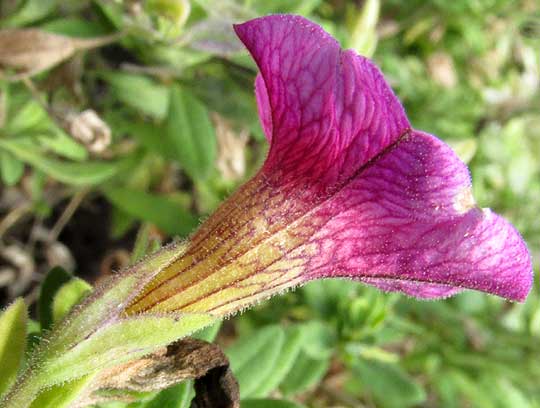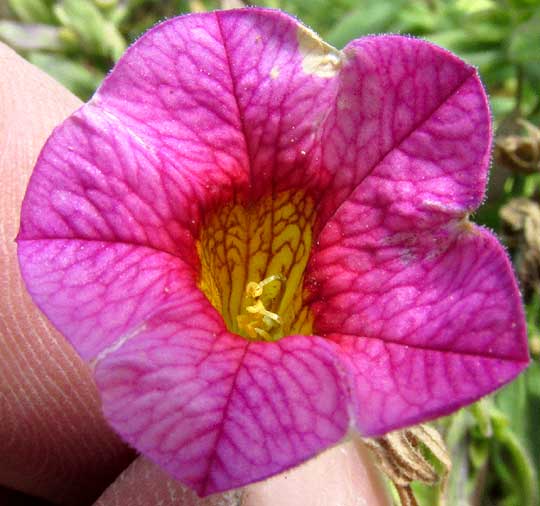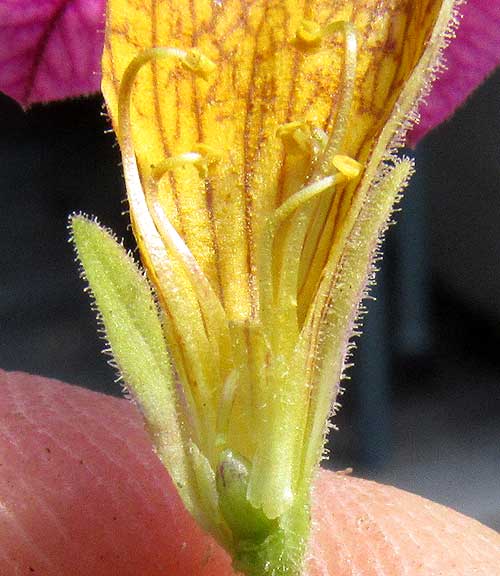Excerpts from Jim Conrad's
Naturalist Newsletter
from the October 5, 2014 Newsletter issued from the Frio Canyon Nature Education Center in the valley of the Dry Frio River in northern Uvalde County, southwestern Texas, on the southern border of the Edwards Plateau; elevation ~1750m (~5750 ft); N29.62°, W99.86°; USA
CALIBRACHOA, NOT PETUNIAS
On my neighbor Phred's sundeck a bushel-basket-size potted plant has spent much of the summer spectacularly arrayed with pinkish blossoms. Below, you can see a small corner of the plant with several flowers amidst numerous brown, curled-up remains of previous flowerings:

All summer I've assumed that the plant was a special clumping, dwarf petunia. Below, a blossom's side view displays the typical petunia flower shape:

A pretty view into the blossom's mouth is shown below:

If you open up the blossom you see the petunia's special stamen arrangement, which consists of there being five stamens with two pairs displaying different lengths, and they all arise at the corolla's base, not halfway up the corolla tube, as shown below:

So, everything here says petunia, petunia, petunia... but when I began looking for a petunia cultivar looking like this, nothing came up. Eventually it grew clear that a closely related genus needed to be sought, though I'd not heard of such thing. However, such a genus does exist, one referred to by taxonomists as the genus Petunia's "sister group." The term sister group is applied to a taxonomic unit's closest relative. The assumption is that at some point during evolution a species "split," in our case one descendant evolving to become petunias while the other group produced offspring such as those turning up in a pot on Phred's sundeck.
Phred's sundeck plant is a member of the genus Calibrachoa, a genus that, like Petunia, is South American in origin but now much cultivated worldwide. Calibrachoa species look like Petunia species, but they don't interbreed -- thus constituting different genera -- if only because Petunia species have 14 chromosomes while those in Calibrachoa have 18.
On the Internet, plants looking like ours go by the binomal CALIBRACHOA x HYBRIDA 'MILLION BELLS.' The " x hybrida" means that two or more Calibrachoa species were hybridized to create our plant, and "'Million Bells'" is the cultivar name. A technical paper published in 2010 deals with 91 commercial Calibrachoa cultivars. The cultivars also come in various forms. For example, there's 'Million Bells Flamingo Pink,' which might be the one on Phred's sundeck, and 'Million Bells Apricot." And many cultivars further come in double flower forms, and/or trailing, mounding or more compact "bouquet" types.
So, if you can't check a plant's chromosome number, how do you know whether you have a Petunia or a Calibrachoa? I'm not sure that the non-expert can, though, in general, flowers on plants sold as petunias are larger and are less likely to mound up, while the Calibrachoa cultivars most commonly seen on sale produce small flowers, form dense mounds and flower prodigiously during all the warm season.